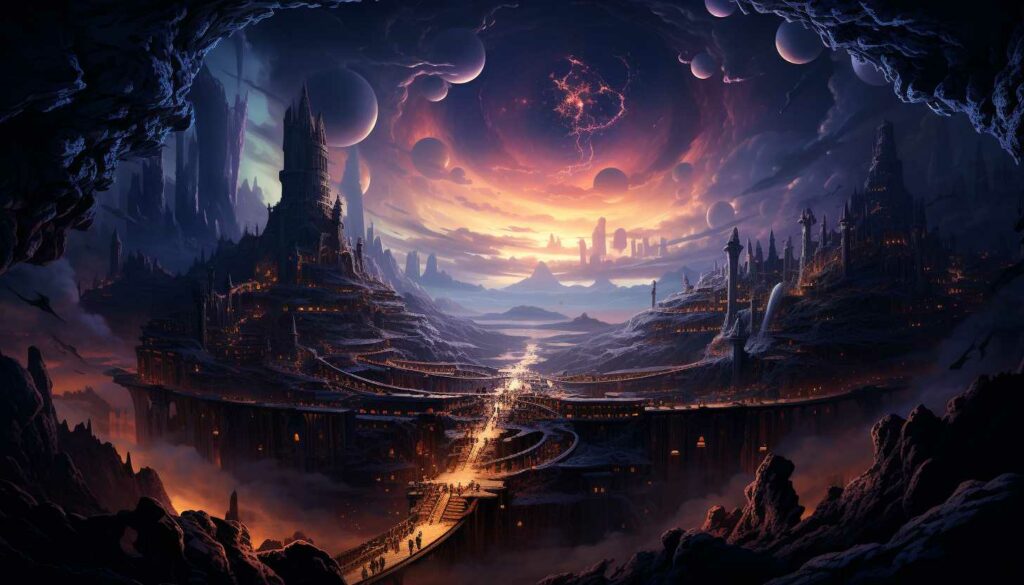Are you curious about the spiritual realm, a dimension beyond our physical reality that remains largely unseen? The belief in this higher plane of existence is found in numerous religions and philosophies worldwide.
This blog post is going to unravel the mysteries of the spiritual realm, explaining its nature, relevance to everyday life, and laws governing it. Read on for an enlightening journey into the world beyond our senses!

Unleash Your True Potential!
Explore the world of meditation with our powerful guided sessions crafted to bring peace and strength to your spirit.
But first, let’s ensure our sessions are the perfect fit for you.
Take our short quiz to find out!
Table of contents
What is The Spiritual Realm?
The spiritual realm is the unseen dimension where spiritual beings and forces exist, and it plays a very significant role in shaping and shifting our lives and understanding of reality. It is a reality beyond our natural world. It’s where spirits live and can often influence the material and daily life.

Spiritual Realm Definition
The spiritual realm is a new place we find when using the spiritual practices. It’s a different world where you meet others and act as a part of it. Like us, this spirit world has its laws. For example, God’s laws rule both earth and this sphere.
The Bible shows that humans have a spiritual side since they are made in God’s image. This spirit world links us to ourselves, to other people, and to life itself.
Spiritual Realm Meaning
The spiritual realm is a special place. It’s not like the world we see and touch every day. This place has both good things, like God and his angels, and bad things, like the devil and demons.
People believe that in this spirit world, words have a lot of power. What you say can change your life.
According to the tenets of Spiritualism, the spirit world constitutes the world where spirits, whether benevolent or malevolent, manifest in diverse forms. This world is perceived as an external environment designed for the existence of these spirits. Furthermore, it serves as a channel for spiritual interactions and encounters.
This spirit world is more than just places or things. It does not have time or space as we know it. Many people think that it vibrates with energy all the time too! The spirit inside us helps us feel this energy if we’re open to it.
Theories
There are a lot of theories about the spiritual realm. Here are some of them:
- The spirit world is full of good and evil spirits. This idea comes from Spiritualism.
- Many faith groups say there are many realms. We live in world, but there are others too.
- Some people believe that our spirit can talk to God and see into the spiritual realm.
- The spiritual realm covers all parts of a person’s life and their feelings.
- The Bible says that the spiritual realm has both good and bad beings.
- They also believe that special laws control how things work in the spirit world.
The Supernatural and Spiritual Realm
In the supernatural and spiritual realm, there is a constant battle between good and evil, as depicted in various cultures and religions around the world.
Good vs. Evil
In the spiritual realm, there is a battle between good and evil. This has been mentioned in religious texts like the Bible. The spiritual realm consists of both good entities, such as God, and evil entities, like the devil.
Demons in the spiritual realm are known to promote various evils and manipulate people. It’s important to understand this battle between good and evil because it influences our everyday lives and physical reality.
In this world, there are spiritual laws that govern how things work. One example is the law of sowing and reaping, which means that individuals will experience consequences based on their actions.
The Bible’s Perspective
The Bible provides insight into the spiritual realm, stating that it consists of both good and evil spiritual beings. It teaches that the spiritual realm is invisible yet real, encompassing our body, soul, and spirit.
Reading the Bible is considered a supernatural act requiring God’s power. It also emphasizes that humans can operate in the spiritual realm and interact with spiritual beings through God’s guidance.
The Bible acknowledges that there is a battle taking place in the spiritual realm called spiritual warfare. In ancient times, people believed that the supernatural and spiritual realm had control over everyday life and determined one’s eternal destiny.
The belief in a spiritual realm across cultures and religions
Belief in the spiritual realm is something that can be found all around the world, in different cultures and religions. It seems that humans have a very natural inclination towards the supernatural.
No matter where you go, you’ll find people who believe in higher realms and unseen powers. While these beliefs may vary from culture to culture, there are often common elements when it comes to supernatural beliefs.
For example, many belief systems include ideas about angels and demons – beings that act as mediators between the spiritual and physical worlds. This belief is widespread across different cultures, showing that there is a universal recognition of these spiritual forces.
The Influence on Everyday Life And Physical Reality
The spiritual realm has a significant influence on our everyday lives and physical reality. Even though we cannot see it, the unseen laws of the spiritual realm can greatly impact us.
Our beliefs about the supernatural and spiritual beings like God, the devil, and demons shape how we perceive and navigate the world around us. Spiritual experiences can also open our minds to a larger reality, helping us understand ourselves and our place in the human community better.
African traditional religious practices have influenced Christian spirituality by providing insights into concepts like the spiritual realm and its laws. These ideas are explored in various sources like books and research articles to help us make sense of our experiences beyond what we can see with our eyes.
Evidence of the Spiritual Dimension

Scientists have conducted numerous studies on spiritual experiences and near-death experiences, providing compelling evidence for the existence of a spiritual dimension.
Spiritual Experiences
Spiritual experiences are moments when people feel a strong connection to something greater than themselves. These experiences can happen in different ways and can be very personal. Here are some examples of spiritual experiences:
- Meditation: People who meditate often have spiritual experiences. They may feel a deep sense of peace and calmness, or they might feel connected to a higher power.
- Lucid dreaming: Some people have lucid dreams, where they are aware that they are dreaming while it’s happening. In these dreams, people sometimes have profound spiritual experiences.
- Out-of-body experiences: Some people report having out-of-body experiences, where they feel like their consciousness is separate from their physical body. These experiences can be spiritual and transformative.
- Near-death experiences: People who have had near-death experiences often describe seeing a bright light or feeling a loving presence. These powerful moments can change their perspective on life and death.
- Hallucinogenic plants and drugs: Some individuals use hallucinogens like ayahuasca or magic mushrooms to seek spiritual experiences. These substances can alter perception and lead to profound insights.
Near-Death Experiences
Near-death experiences (NDEs) can provide evidence of the spiritual realm and offer a glimpse into what lies beyond our physical reality. Here are some important facts about NDEs:
- Increased empathy: NDEs have been known to lead to a greater sense of empathy towards others.
- Life beyond death: Many people who have experienced NDEs believe that death is not something to fear and that life continues after we leave our physical bodies.
- Stronger spirituality: NDEs often result in individuals feeling more connected to their inner selves and embracing a more spiritually oriented outlook.
- Improved well-being: Those who undergo NDEs frequently report an increased sense of well-being on a spiritual level.
- Mystical experiences: NDEs can be seen as mystical encounters characterized by positive values, attitudes, beliefs, and emotions.
- Similarities with DMT effects: The psychedelic compound DMT can produce experiences similar to aspects of NDEs, such as transcending the body and entering alternative realms.
- Encounters with religious figures and deceased loved ones: During NDEs, individuals often report interacting with religious figures or communicating telepathically with deceased relatives.
Scientific Studies
Scientific studies are increasingly investigating the connection between spirituality and various aspects of human life. Various bodies of research have explored the relationship between religion or spirituality and mental and physical health, the presence of spiritual events across different levels of formal education, and the intersection between science and spirituality.
| Study | Findings |
|---|---|
| Koenig, H.G. (2012)1. Religion, Spirituality, and Health: The Research and Clinical Implications. | Explored the connection between religion and spirituality and health. Concluded that individuals with strong religious and spiritual beliefs tend to have better mental health and adapt more quickly to health problems. |
| Astin, J.A. (1997)2. Stress reduction through mindfulness meditation. | Found that mindfulness-based stress reduction programs can improve psychological status, reduce stress, and enhance the quality of life. |
| Van Ness, P.H. and Kasl, S.V. (2003). Religion and cognitive dysfunction in an elderly cohort. | Explored spiritual events across different levels of formal education. Discovered a very significant association between higher levels of religious participation and lower levels of cognitive impairment. |
| McCullough, M.E3. (2000). Forgiveness as human strength: Theory, measurement, and links to well-being. | Explored the concept of forgiveness in religious contexts, finding links between forgiveness and improved mental health. |
| Schneider, R. (2010). Where Science and Spirituality Meet: The Convergence of Quantum Physics and Mysticism. | Discussed the intersection between science and spirituality. Proposed that views in quantum physics and mysticism share similarities. |

Unleash Your True Potential!
Explore the world of meditation with our powerful guided sessions crafted to bring peace and strength to your spirit.
But first, let’s ensure our sessions are the perfect fit for you.
Take our short quiz to find out!
Understanding the Spiritual Realm
The understanding of the spiritual realm includes recognizing its characteristics, purpose, and connection to ultimate reality.
Characteristics
The spiritual realm has certain characteristics. These include:
- Devout praise of God
- Ruled by God
- Inhabited by good and evil spirits
- Represents the invisible part of individuals (body, soul, and spirit)
- Represents all things and parts of an individual in some way
Purpose
Understanding the purpose of the spiritual realm is essential for devoutly praising God and finding deeper meaning in life. It allows us to grasp the existence of a higher reality beyond our world, where spiritual beings and forces reside.
By understanding this world, we can cultivate a stronger connection to ultimate reality and gain wisdom about how to navigate daily life. The spiritual realm provides us with insight into the nature of good versus evil and the ongoing battle between them.
It opens our eyes to the unseen dimensions that influence our emotions, thoughts, and actions. Ultimately, comprehending the purpose of the spiritual realm empowers us to live more fully in faith and embrace a greater sense of hope in our journey through this world.
Connection to Ultimate Reality
Our connection to ultimate reality is a fundamental aspect of the spiritual realm. It involves understanding and experiencing a higher power or force that exists beyond our world.
Many people believe in the existence of this connection, whether it’s through faith, spirituality, or personal experiences. Major religions teach that our ultimate reality goes beyond our material bodies, and that there is something greater at play in the universe.
Plato’s philosophy also suggests the concept of two realms – the physical and the spiritual – with the latter being more real and eternal. This connection to ultimate reality provides us with a deeper understanding of ourselves, our purpose in life, and our place in the larger cosmos.
The Laws of the Spiritual Realm

Read on to discover the fascinating laws that govern the spiritual realm and gain a deeper understanding of this mysterious dimension.
10 Spiritual Realms
The spiritual realm consists of 10 different realms, each with its own characteristics and purposes. These realms are:
- The Realm of Angels: This world is inhabited by angelic beings who serve as messengers and protectors.
- The Realm of Demons: In contrast to angels, this world is inhabited by evil spirit and malevolent beings that seek to deceive and harm and it represents spiritual darkness.
- The Realm of Spirits: This world includes the spirits of deceased humans, who may still be present in the spiritual realm.
- The Realm of Deities: In some belief systems, there are higher beings or gods that reside in this realm.
- The Realm of Divine Consciousness: This world represents a state of pure awareness and connection with the divine.
- The Realm of Ascended Masters: Spiritual teachers and enlightened beings dwell in this world, offering guidance to seekers.
- The Realm of Nature Spirits: This world is home to elemental beings like fairies, gnomes, and sprites.
- The Realm of Ancestors: Ancestors who have passed away often reside in this world, offering wisdom and protection to their living descendants.
- The Astral Plane: This intermediate world serves as a bridge between the physical world and other spiritual dimensions.
- The Akashic Records: This ethereal world contains the collective knowledge and experiences of all souls throughout time.
Spiritual Realm of Authority
Spiritual realm of authority refer to the domains or areas where individuals have been given the power and responsibility to operate in the spiritual realm. According to important facts, God has equipped people with spiritual authority as a gift through the Holy Spirit.
This means that believers have the right to receive and use God’s power in their lives. Constituted authority is established by God, showing that He has ultimate control over both visible and invisible realms.
In these worlds, devout praise of God takes place and His rule is acknowledged. It’s important to note that sin can block our ability to see into the spiritual realm, but through spiritual authority, we can tap into God’s power for guidance and protection in our everyday lives.
The Seven Laws of the Spirit World
The Seven Laws of the Spirit World are:
- The Law of Divine Oneness: Everything in the spiritual realm is connected and part of a greater whole.
- The Law of Vibration: Different realms within the spiritual world have their own unique vibrations and frequencies.
- The Law of Correspondence: As above, so below – the spiritual realm mirrors the physical realm and vice versa.
- The Law of Cause and Effect: Actions in the spiritual realm have consequences, just like in the physical world.
- The Law of Attraction: Like attracts like – our thoughts and energy attract similar experiences in the spiritual realm.
- The Law of Non-Resistance: Resisting negative energies or experiences only strengthens them. Acceptance brings growth.
- The Law of Intentions and Desires: Our intentions and desires shape our experiences in the spiritual realm.
Spiritual World Vs. Physical World

The spiritual world and the physical world are two separate planes of reality. In the physical world, we live in tangible bodies and experience life through our five senses. We interact with other people and things that exist in the material world.
On the other hand, the spiritual world is inhabited by spirits, both good and evil. It is a world beyond our physical perception where different laws and principles operate. While we can see, touch, hear, taste, and smell things in the physical world, we cannot directly perceive or interact with the spiritual realm using our physical senses.
However, many people believe that there are ways to access or connect with the spiritual world through practices such as prayer or meditation.
Conclusion
In conclusion, the spiritual realm is a place where God rules and where good and evil entities exist. It is considered a higher dimension of existence and is seen as crucial to understanding human existence.
Although the laws of the spiritual realm are not explicitly defined, they govern the interactions between spiritual beings and the physical reality. Exploring the spiritual realm can provide insights into ultimate reality and deepen our understanding of life’s mysteries.
FAQs
How do you see into the spiritual realm?
Seeing in the spiritual realm comes from believing, focusing on truth taught by church or realizing through personal experiences.
Is there any difference between physical realm and spiritual realm?
Yes, the material world is what we can touch and see in our daily life while the spiritual realm inhabited by spirits may not be seen but can be felt.
Is evil one part of this spirit Realm?
Yes, both good forces like heaven and evil ones exist in this spirit realm as part of creation affecting us even without us knowing sometimes.
Can practices help us connect with this Spiritual Reality more?
Yes, certain practices like prayer or meditation make it easier for people to feel connected to the spirit realm without doubt.
- Taking Faith in the Future! 4 Ways Religious Involvement Can Help You Age Well – Biblical Psychiatry. ↩︎
- Kempermann, Gerd. “Making DEEP Sense of Lifestyle Risk and Resilience.” Frontiers in Aging Neuroscience, vol. , no. , 2019, p. n/a. ↩︎
- Abid, Momina, and Shamsa Hussain. “Forgiveness: It’s Relation with Psychological Well-being and Psychological Distress among Old Age Women.” Indian Journal of Positive Psychology, vol. 6, no. 4, 2015, pp. 340-343. ↩︎










